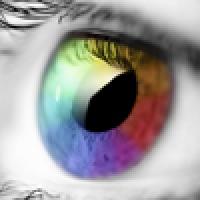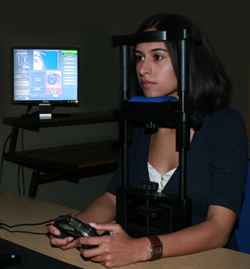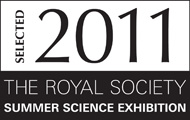
Can triangles help spot a bomb?
Airport security staff have a daunting task. With impatient queues looming over them they need to search x-ray scans of cluttered suitcases for several items at once: knives, guns and bombs. How can we ease their task and make sure they don't miss a crucial item? To find out, scientists at the University of Southampton are trying to understand how we humans take in visual information. They are presenting their work at this year's Royal Society Summer Science Exhibition 2011, which runs from the 5th to the 10th of July. The humble triangle plays a crucial role in the experiments they perform.

Diagram 1
Eye tracking experiments record the eye movements of volunteers looking at an image on a screen to see what kind of visual features their eyes latch onto. It's important to know how big the visual stimuli on the screen are, but size is in the eye of the beholder. Even the biggest things look small when you're far enough away.
A clever way of taking account of this is to measure size in terms of the visual angle. The length of an object in an image, for example a knife, is measured in terms of the angle formed by the two lines starting at your eye and ending at either end of the object (see diagram 1). Using the visual angle to measure size, scientists can accurately compare results of different experiments that may have been run in laboratories with different sized stimuli and different viewing distances.
But how can you work out the visual angle from the actual size of an object on a screen and vice versa?

Diagram 2

An eye tracking experiment.
The visual angle is the standard way of measuring size in vision science, whether it's about improving airport security or understanding the psychology or biology of vision. It's also a favourite with astronomers, who for centuries have been using visual angles to describe the size of the Moon, the Sun and other celestial objects as viewed from Earth.
This article accompanies an exhibit at the Royal Society Summer Science Exhibition 2011 entitled Guns, knives, and bombs: How do airport security screeners spot weapons in x-rays of passenger baggage? It is part of the Maths Inside project, run by the Mathematics Promotion Unit (a collaboration between the London Mathematical Society and the Institute of Mathematics and its Applications) in conjunction with Plus and the Royal Society.
 |
 |
|
|
Comments
Anonymous
I didn't really get the connection between the airport security staff and the visual angle mathematics? How does knowledge of the equations of the visual angle assist security staff in any way? After the opening paragraph there was no further mention of airport security or how this maths was of use in practical applications.
I normally enjoy Plus articles very much, but unless I missing something obvious (in which case apologies!), this one doesn't quite follow through on its premise.
Marianne
Sorry if it's not clear - the visual angle is used in all sorts of research into vision. The researchers of this particular exhibit use it to find out how we look at items on a computer screen. Their results help them devise better ways of displaying the information from x-rays, for example through 3D screens, which will make airport staff's task of searching for several kinds of items at the same time easier.